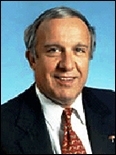GMAC Financial Services (GMAC) is under scrutiny today after an announcement late yesterday that its head had departed and a new CEO, Michael A. Carpenter, was coming in from the financial services industry.
The bank holding company remains in trouble over bad loans in the housing and auto markets.
The appointment of Carpenter, with disputed accounts of whether the previous CEO, Alvaro de Molina, was fired or resigned, also raised questions about the reckless practices of Wall Street, which is responsible for the ongoing Great Recession and the collapse of the global banking system.
What this means for car buyers or U.S. taxpayers is not immediately clear — beyond the obvious observation that the credit markets are still not fixed and more raids on the U.S. Department of the Treasury are forthcoming.
This is wreaking havoc with the economy, which has the highest unemployment rates since the Great Depression, and as the Obama Administration privately contemplates another stimulus programs to fix its previously failed stimulus program that was an attempt to fix the failed economy under the Bush Administration.
Carpenter, 62, has only served on the GMAC board since May of this year. His previous experience includes CEO positions at Citigroup’s Global Corporate & Investment Bank, Salomon Smith Barney, Travelers Life & Annuity and Kidder Peabody. During his 35-year career, Carpenter has also held senior positions at GE Capital, General Electric and Boston Consulting Group.
The Obama Administration has thus far been unable to implement any reforms whatsoever in financial regulation more than one year after the collapse of the Lehman brothers or AIG, among others, last fall.
Perhaps most troubling for taxpayers, who have already bailed out bankers and irresponsible financial institutions with almost a trillion dollars in borrowed money — that is trillion — is that the board of GMAC also said that it had asked the Treasury to postpone its decision on an additional injection of capital.
GMAC had been negotiating another capital increase of as much as $5.6 billion, but in published reports it said it would no longer seek that much.
This latest bailout was to come this month from the Troubled Asset Relief Program funds, which are so unpopular with taxpayers.
Treasury said it had nothing to do with the dismissal of de Molina.
GMAC said in a statement that until Carpenter and the management have assessed the current situation and can advise the board and Treasury regarding the “appropriate amount” of such funding, Treasury should not proceed.
GMAC also said in the statement that Carpenter is resigning from the board of CIT Group Inc., the bankrupt commercial lender.
Carpenter’s background does not exactly inspire confidence in me, a taxpayer, who keeps bailing out Wall Street and financing outrageous bonuses without getting any reforms or potential returns on our investments.
Taxpayers have already financed two previous GMAC bailouts totaling $13.5 billion.
This leads to reasonable speculation that the situation of the company is more dire than previously represented, and that more than $5.6 billion is needed to clean up the mess. Another possibility is that GMAC needs to close down one or more of its operations so that it will not have to borrow as much, and can escape from federally imposed compensation limits so that it can go back to paying fat bonuses.
GMAC’s home mortgage business looks to be a like target for bankruptcy under such a strategy.
Taxpayers are the biggest owner of privately held GMAC, with a 35.4%. GMAC’s old owner, General Motors, holds a 9.9%. U.S. taxpayers, of course, hold 60% or a controlling interest in General Motors Company, which has just reported a $1.2 billion loss after emerging from a treasury directed bankruptcy. Capital Management LP, the New York-based investment firm, which was a previous owner of the bankrupt Chrysler Corporation, holds 22%.
GMAC is a bank holding company with 15 million customers worldwide. As a global, financial services institution, GMAC’s business operations include automotive finance, mortgage operations, insurance, commercial finance and online banking. As of Sept. 30, 2009, the company had approximately $178 billion in assets. The question remains what are the actual liabilities. In addition, more important for taxpayers, who pays for them?


Let the bums die…Ch.7. We called numerous times last week for a re-mortgage and wasput on hold everytime leaving our phone number. They never once called back.